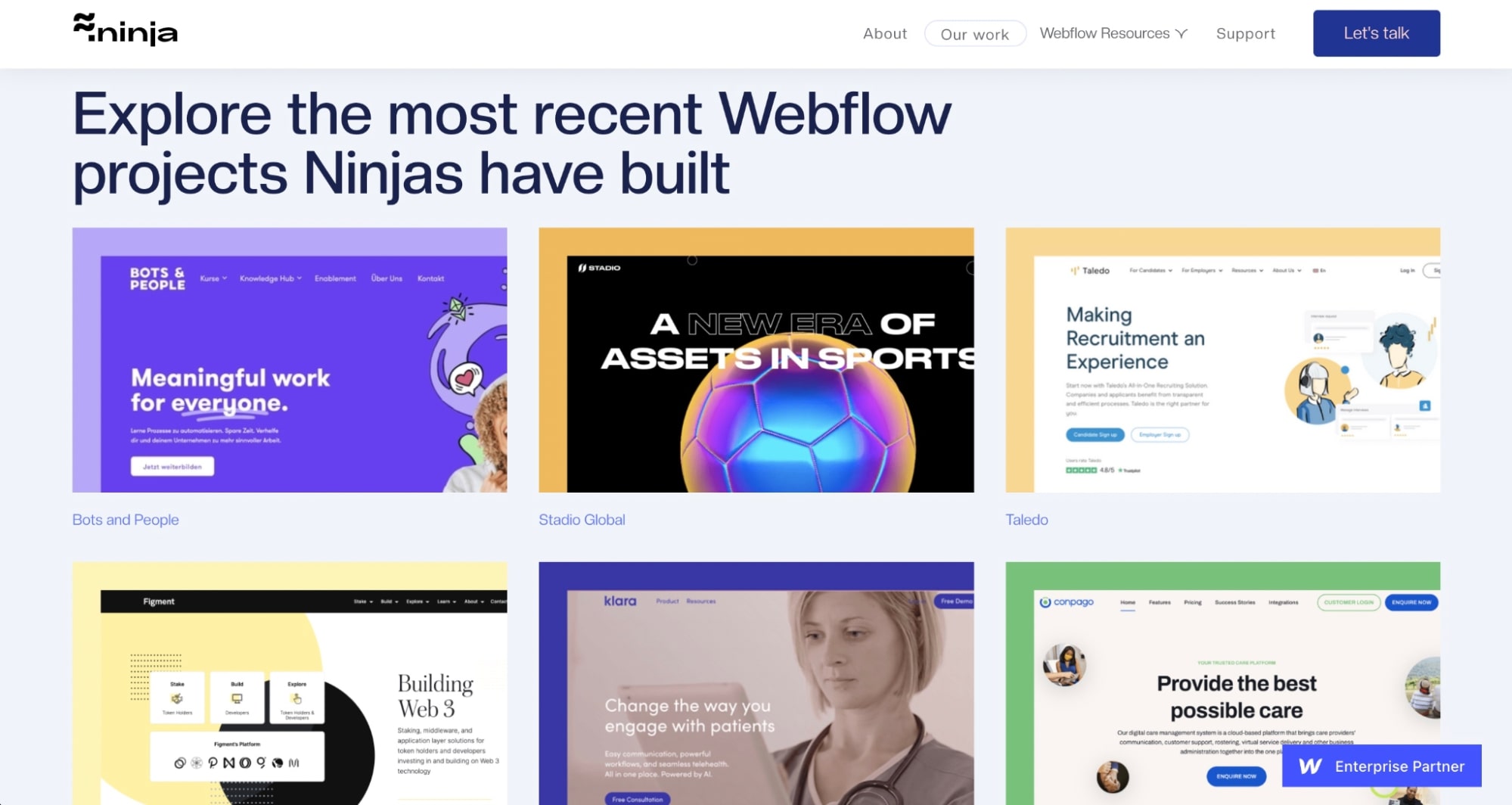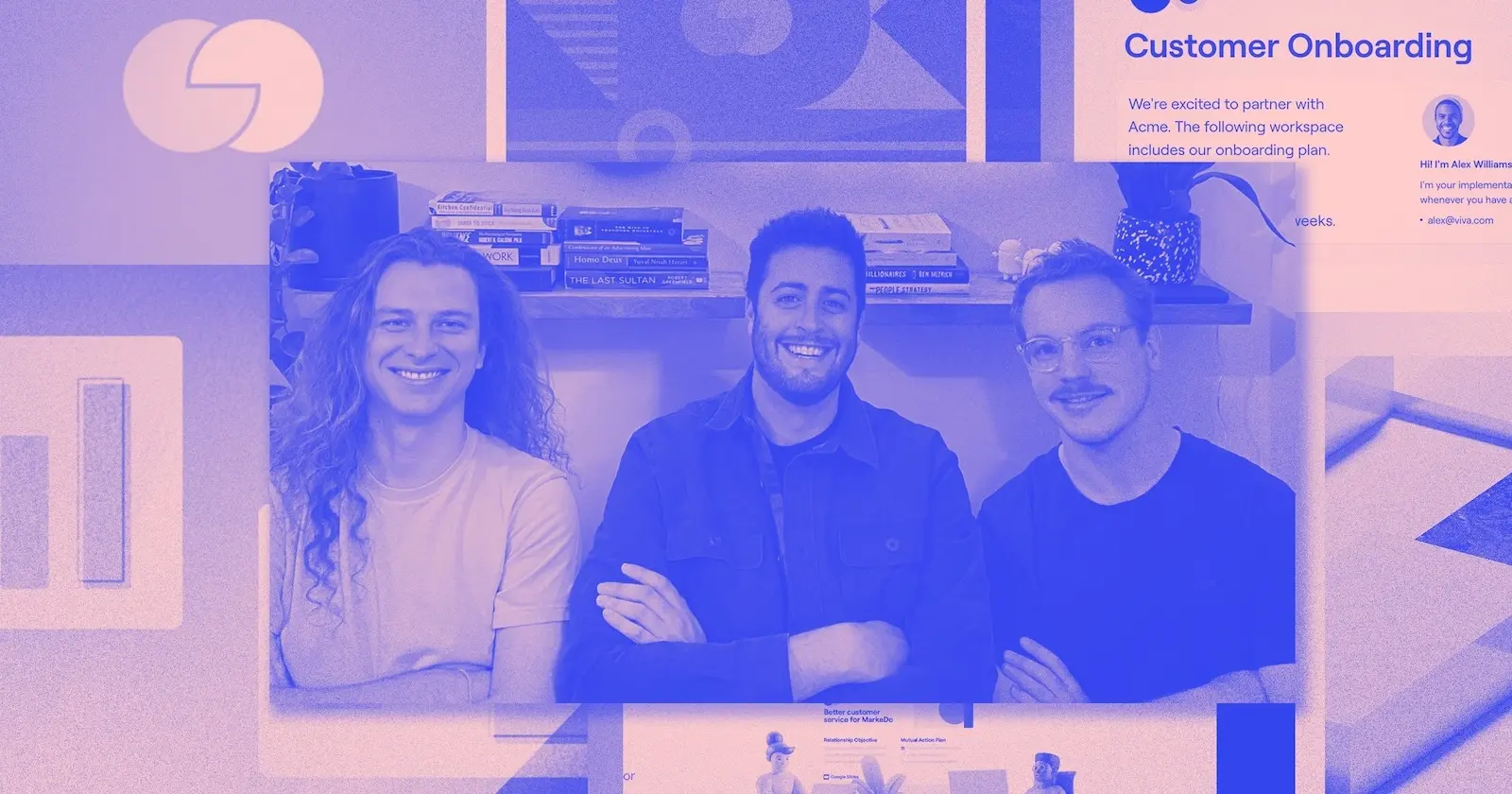Agency work comes with tight deadlines, project juggling, and scores of client demands.
No matter how skilled your team or how smoothly a project is going, it may never feel like there are enough hours in the day. What gets your team excited and keeps your customers happy are the creative parts of your work — crafting beautiful designs, captivating user experiences, and effective, thoroughly-tested conversion-focused websites. The less time you spend stuck in a slow development process, the more time you have for creativity, user-testing, and innovation.
Webflow’s no-code development process can improve your agency’s entire workflow and accelerate your time to market without burdening your team or cutting corners. While running successful web design agencies, Uros Mikic, CEO of FlowNinja, and Taylor Rosenbauer, CEO and Founder of RocketAir, have helped countless companies develop and launch their websites. Each of them have turned to Webflow to accelerate their development process and deliver high-quality results for their clients.
“I wouldn’t say Webflow has competitors, and many of our clients agree,” Uros said, “The only competitor to Webflow is fully-custom development.”
Webflow’s no-code interface makes building websites significantly faster and cheaper than custom development. Taylor and Uros offered their thoughts on why they’ve chosen Webflow as their agencies’ tool of choice and exactly how each feature helps their agencies build faster and better.
With no-code development, your whole team can build faster
The Webflow Designer “allows you to write code visually and to see your changes directly without a line of code,” Uros said. For most, building in a visual canvas is a much more efficient process, even for those with technical backgrounds.
The visual, no-code development process empowers more members of your team to participate in the site build. Designers, copywriters, strategists, and project leads can all build or edit parts of the project without waiting for tickets to go through engineers for changes.
Webflow helps close the gap between design and development by allowing your designers to create directly within the Webflow interface. They can create a living style guide within Webflow that the rest of your team can use to quickly spin up landing pages while maintaining design consistency. Reusable elements like Symbols can be dropped into your design anywhere, and sitewide Classes allow you to make sweeping changes across your site with one click.
Webflow allows us to be a full-service agency without a full-stack team
Webflow writes clean, semantic code as you design, so developers can go in and make custom additions within the code itself when they want to add custom features. The Webflow Designer also ensures you can easily build a responsive website that works smoothly across all devices. You don’t have to build out a separate mobile site, which saves significant development time.
For FlowNinja, using Webflow has empowered them to build enterprise-level websites and platforms with a nimble, more creatively-focused team. “Webflow allows us to be a full-service agency without a full-stack team,” Uros said. With Webflow, the company’s release cycles are less complicated and shorter, leaving more time to do a complete QA process and work on more complex features like animations.

Rapid prototyping makes user research faster and more effective
With Webflow, it’s much faster to get to an actual working prototype of a website than it is with custom development. A prototype in Webflow is interactive and usable, rather than being a static mockup or Figma design.
“The best part is that we can create truly realistic browsing experiences,” Taylor said. “These aren’t simulations, they’re the real thing — which means that we don’t have to ‘fake’ anything in user testing, and our clients get even more accurate data and insights.”
Webflow’s no-code environment has been a game-changer for rapid prototyping
A working prototype will get you better client feedback, and no-code allows you to quickly iterate and implement changes based on that feedback.
“Webflow’s no-code environment has been a game-changer for rapid prototyping,” Taylor said. It has allowed the agency to build in a data-driven way, working with clients to prototype ideas, test them with real users, and use that feedback to validate value propositions or product-market fit.
The goal is to get live digital experiences in front of users as fast as possible. What makes that possible is the scalability of Webflow’s design system. “Taking a design system approach, we can build component libraries and easily deploy variations of different landing pages to A/B test,” said Taylor. Component libraries help you create more landing pages faster, allowing you to run A/B tests on more variables and create a better website faster.
More feedback helps your entire team develop their skills. “We can become much better designers/developers as we see products much faster in the market, and then work on adjusting them to how the market reacts,” said Uros.




















Build websites that get results.
Build visually, publish instantly, and scale safely and quickly — without writing a line of code. All with Webflow's website experience platform.
Easy creation of complex CMS structures makes your site scaleable
Webflow’s CMS structure allows you to quickly populate new pages and collaborate with your clients to scale their website’s content faster. “The CMS allows us to create complex CMS structures unique to our client needs,” Uros said. That CMS structure makes it easy to add as many landing pages as you need with a single template.
Webflow’s Editor allows your clients to access their content in a controlled way, so they can safely contribute to the build. Clients can add and modify their content directly in the CMS and edit existing content directly on the live website. With dynamic CMS Collections, they can create content for their site as you build it out, drafting and publishing product pages, case studies, and blog posts.
The CMS allows us to create complex CMS structures unique to our client needs
For added professionalism, you can whitelabel the CMS, giving your clients a custom portal with branding from your agency or your client’s brand. Webflow’s interface makes the client handoff easy, and you can teach them how to keep the site content updated on their own with minimal support from your team. Projects go to market faster if customers can build out their content in tandem with your site development.
Built-in hosting and security save you time on backend engineering
Backend engineering and building out security features occupy a large quantity of development time in traditional development. With Webflow, high-quality built-in hosting and security mean all of that is taken care of right off the bat.
“(Webflow means) go to production is worry-free. It’s all done in a single click, without worrying about security and backend engineering,” Uros said.
You and your client can manage hosting directly in the Editor and easily purchase or connect custom domains. Sites are hosted on Amazon Web Services, which is fast and reliable and includes a huge server fleet that can handle as much traffic as your client’s business needs. The Client Billing feature streamlines the finances of the project, making payments easy and passing hosting fees directly to clients.
All Webflow sites have automatic backups and versioning, freeing your team from worrying about the project. Webflow’s sites are all highly secure, with SOC 2 Type II certification, automatic SSL, regular pen-testing, two-factor authentication, and the ability to password protect by site or by page. All of that comes standard in Webflow, without any setup or engineering time from your team.
Other benefits speed your development process
While the bulk of your time-to-market is reduced by Webflow’s no-code interface, CMS, and hosting, there are also many more small features that add up to make your build faster and easier.
Features are built-in rather than requiring plug-ins
Webflow offers essential features built-in rather than relying on plug-ins for essential functionality like visual development, SEO, or security.
In WordPress, for example, you are restricted to the limitations of Elementor for visual development. “Webflow (is) a much more flexible tool where you won’t need plug-ins,” explained Uros. “On WordPress, if clients want something as simple as a popup, they need to request a Plugin, pay for it, and make it up to date.”
Support for advanced animations and interaction design
Webflow makes it easier than ever before to create advanced animations and interactions like auto-loading elements, scroll-based parallax, and hover states. “(Animations) are usually incredibly hard to do in the usual development process,” said Uros. When animations and interactions are easier to create, your team can get more creative with their design without sacrificing your schedule.
Enterprise-grade support reduces delays
Webflow’s Enterprise team provides a high level of support that ensures your time to market won’t be delayed by technical issues.
You and your clients will be supported through both the development process and the lifetime of the website. Enterprise gives you access to on-demand phone support, a dedicated customer success manager, and onboarding and training support.
Faster time to market frees you to tackle new ideas and dream projects
Time is a limited — and expensive — resource. Webflow’s faster process frees you and your client to explore new ideas and tackle the more innovative projects that can boost their business. “Clients can start testing ideas that have been on the back(burner) for a long time because of the long development process,” said Uros. “They can shift from maintaining what they currently have to test out new SEO campaigns, new projects/products to see if there’s interest, landing pages for events, and create custom landing pages for reports that had to be PDFs previously.”
Clients can start testing ideas that have been on the back(burner) for a long time
Your client can get so much more value from their website by working with you to build the projects they’ve been dreaming of but didn't have the time or resources to start. Your agency benefits from focusing on tasks that result in more exciting portfolio projects and creating more opportunities to build your skills, innovate, and have more fun with your work. Bring each project to market faster, and instead, spend your time and energy on projects that energize and excite your team and your clients.































